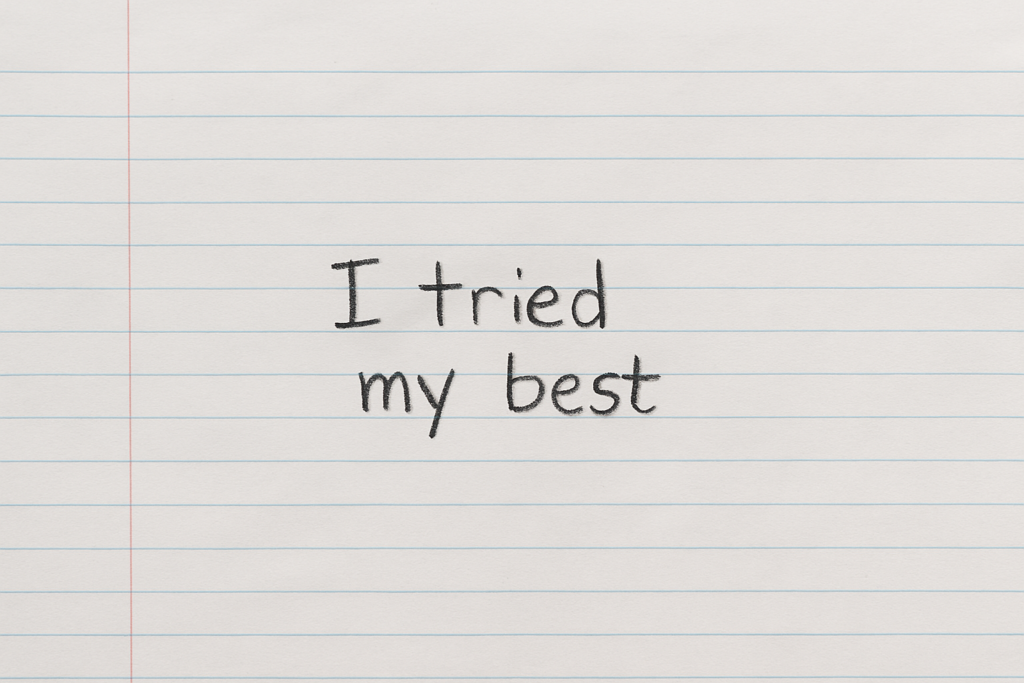Hard to challenge and easy to hide behind
“I tried my best.” This phrase triggers me like no other – whether I hear it in the classroom, at home, or in professional settings. Don’t get me wrong: I value effort. A lot. But too often, “I tried my best” has become a comfortable shield – code for “I did what I could, as long as it didn’t get too uncomfortable.” At worst, it’s a polite cop-out: a vague, nicely packaged excuse that’s hard to challenge and easy to hide behind – and too often silently accepted by teachers. After all, who wants to call a child’s “best” into question? But I’ve seen this line used not as evidence of real effort, but as a way to avoid feedback and dodge accountability.
And that’s not growth. That’s not how skills are built.
Don’t be sorry. Be better!
Even harder to take? When “I really tried my best” is followed by “I’m so sorry.” That’s when I feel resistance rising. If you really tried your best: don’t be sorry, be proud. And if “I really tried my best” is just a phrase – don’t be sorry either. Be better. Try again. Try harder. Because while trying matters, it’s not the end of the story. Learning is hard. It should be.
This article explores why discomfort and challenge are essential to real learning. We’ll look at what hard really means in education, why effort alone isn’t enough, and how platforms like enduri help students meet hard with structure, reflection, and persistence — not avoidance.

A vague, nicely packaged excuse that’s hard to challenge and easy to hide behind – and too often silently accepted by teachers. After all, who wants to call a child’s “best” into question?
Challenging the “Easy = Good” Mindset
Reframing “hard” as positive
In schools and homes, many assume that struggle means something’s wrong. A student who hits difficulty often feels like they’re failing. But this assumption is flawed. When learning is hard, the brain is often stretching and growing. We need to reframe “hard” as a positive. Struggle means you’re pushing boundaries. Education leader Nick Alchin calls avoiding hard learning “a profound mistake” [1]. Research shows that easy learning fades quickly, like writing in sand. Struggle leads to durable understanding [3].
The Science of Productive Struggle
Challenge the brain….
Why does difficulty boost learning? Cognitive science shows that effortful activities like self-testing or mixed practice deepen understanding. They’re uncomfortable but effective. Researchers Elizabeth and Robert Bjork highlight “effortful recall” as a key to retention. Re-reading feels easy but is deceptive. Real learning happens when the brain is challenged to retrieve or apply knowledge [3].
This kind of productive struggle often happens in what psychologist Lev Vygotsky called the Zone of Proximal Development (ZPD) [6] – a pivotal zone where learning occurs just beyond a student’s current ability. It describes the range between what a learner can do alone and what they can accomplish with guided support.
…and do not eliminate the challenge
This support might include scaffolding techniques like modelling, prompts, cues, or strategic questioning. The aim is not to eliminate the challenge but to help the learner stay engaged and gradually develop independence. When learners succeed after grappling with difficulty, they gain not only new knowledge but also confidence. Psychologist Albert Bandura called these “mastery experience” – the most powerful driver of self-efficacy, or belief in one’s ability to succeed [4].
Beyond “I Tried My Best”: Effort vs. Effectiveness
Trying alone doesn’t equal learning
Every teacher has heard “But I tried my best!” Yet trying alone doesn’t equal learning. A student might spend hours on homework using poor strategies and make little progress. Praising effort without improvement can backfire. Carol Dweck, author of Mindset, warns against equating effort with achievement. Students need effective strategies, feedback, and adaptability – not just energy. She also notes that well-meaning teachers sometimes praise effort even when no learning has occurred, which ultimately lowers expectations [2]. Instead of validating effort alone, we should respond with, “I believe you tried — now let’s look at what to try next.”
Building Resilience and Growth Mindset
Do not chase ease, cultivate strength of character
Struggling and succeeding builds resilience: the belief that “I’ve done hard things before, so I can do this too.” These moments create a positive feedback loop – Don’t be sorry. Be better. In a true growth mindset, students understand that abilities develop through persistence and strategy. A student might start the year saying, “I’m bad at writing,” and finish by saying, “Writing is still hard, but I’ve improved a lot.” Alchin reminds us that education should not chase ease but cultivate strength of character [1]. Teachers and parents can help by sharing their own struggles and highlighting progress over perfection.
Turning “Hard” into Rewarding with enduri
Enter the productive zone of challenge
Hard doesn’t mean hopeless. That’s where enduri comes in – a platform designed to turn structured effort into deep, lasting learning. The turtle in enduri’s logo symbolizes slow but steady progress. The platform helps learners build endurance through planning, reflection, and research-backed strategies.
To find the right strategy, students begin by creating a Learning ID – a brief reflection on their goals, strengths, needs, and motivation. A student might say, “I want to expand my French vocabulary,” and enduri offers actionable steps.
Based on the Learning ID, the platform suggests study strategies like active recall, spaced repetition, concept mapping, and self-testing. It personalizes the learning journey, so students work in that productive zone of challenge — never overwhelmed, never coasting.
Reflection, Repetition, and Reward
Instead of just “try their best” ….
They get better. Learning is a cycle: try, get feedback, revise, and try again. Educational researcher John Hattie emphasizes that challenge is essential. “If students are not challenged, they won’t make mistakes — and without mistakes, feedback becomes useless” [7].
…they get better!
That’s why enduri encourages reflection after each session: What worked? What didn’t? What will you do differently next time? It also promotes repetition — revisiting tough topics to build mastery and confidence. Students don’t just “try their best.” They get better. They learn how to learn.
Conclusion: Hard Is Good — So Let’s Act Like It
The brain is working. Growth is happening.
Let’s stop treating “hard” as something to avoid. In learning, hard is often good. It means the brain is working. Growth is happening. So, the next time a student says, “I tried my best,” pause. Don’t let the conversation end there. Ask, “What did you try? What did you learn? What will you try next?”Let’s build a culture where students don’t fear struggle — they engage with it. Where effort leads to insight. Where tools like enduri support students not just to try, but to grow.
Sources
- Nick Alchin (2025). Hard is Good. Or more precisely, Good is often. https://nickalchin.com/hard-is-good-or-more-precisely-good-is
- Carol Dweck (2015). Carol Dweck Revisits the Growth Mindset. Education Week.
- Brown, Roediger, McDaniel (2014). Make It Stick: The Science of Successful Learning. https://www.hup.harvard.edu/books/9780674729018
- Lee Ann Jung (2022). Thriving in the Zone of Productive Struggle. ASCD Educational Leadership.
https://www.ascd.org/el/articles/thriving-in-the-zone-of-productive-struggle - Tricia Taylor (2020). Why ‘Good Effort’ Isn’t Good Enough. Tailored Practice Blog.
- Vygotsky, L.S. (1978). Mind in Society: The Development of Higher Psychological Processes.
- John Hattie (2012). Visible Learning for Teachers: Maximizing Impact on Learning.

